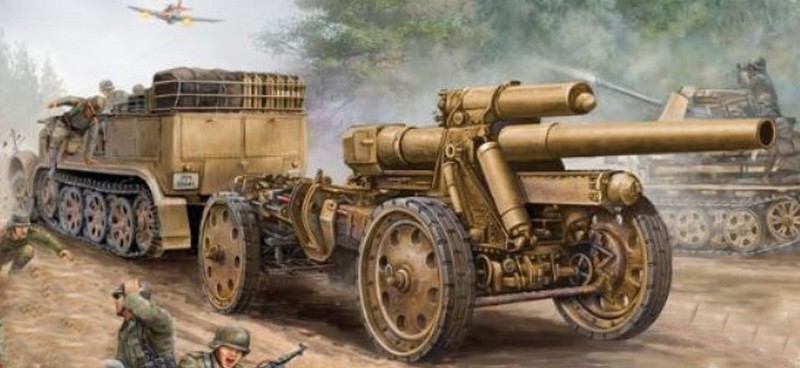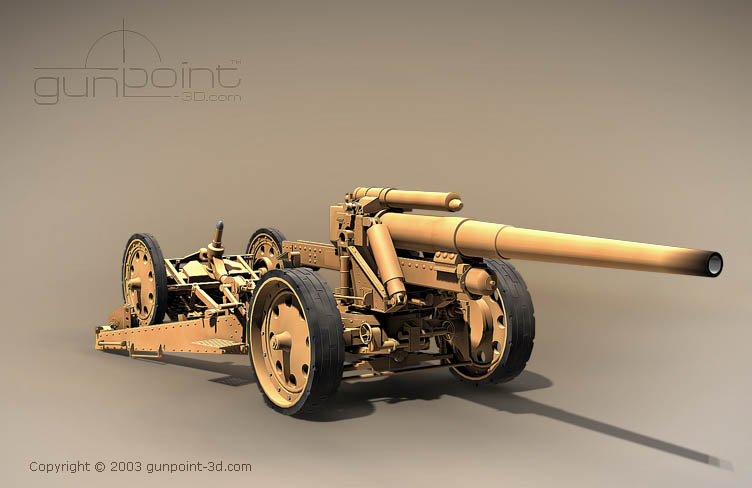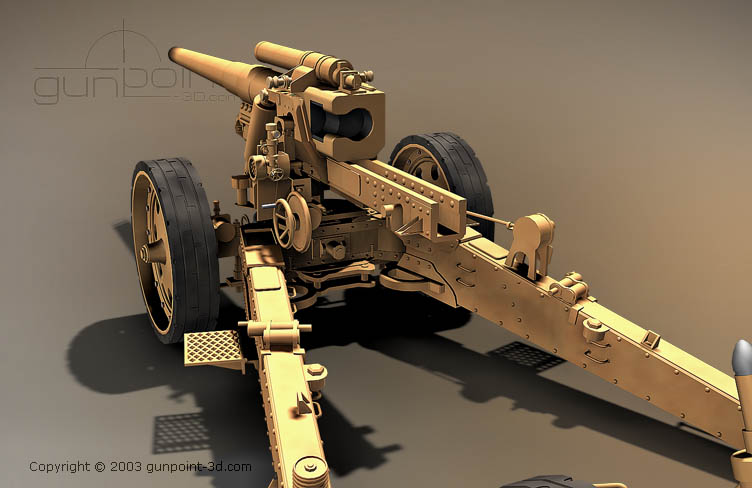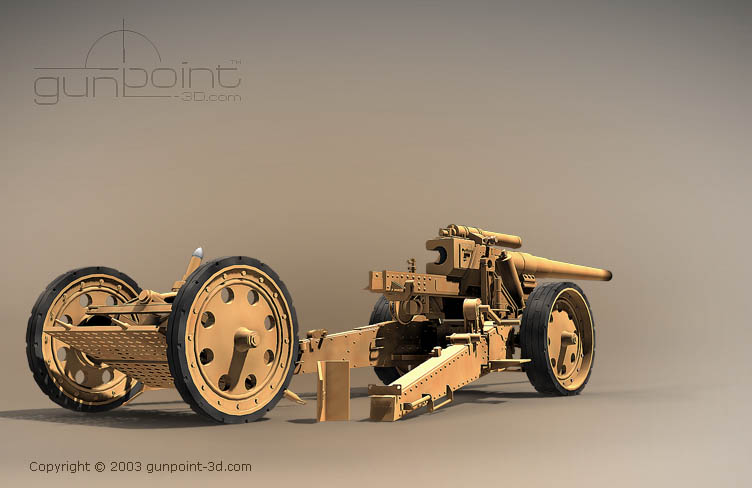


 |
Le canon et l'obusier sont l'un comme l'autre des pièces d'artillerie .Cependant il y a entre eux des différences essentielles de conception et surtout de mise en oeuvre tactique pendant la bataille.
Aux yeux du commun des mortels le canon et l'obusier sont une seule et même chose mais pour l'œil du spécialiste ce sont deux armes très différentes.
D'ailleurs ils ne sont pas construits de la même manière et ensuite leur emploi tactique et leurs objectifs sont différents.
Durant des siècles, le canon a été la pièce d'artillerie la plus commune. La caractéristique du canon est son angle d'élévation réduit quand il tire. Son projectile durant le vol suit une ligne proche de l'horizon.
 |
 |
| Tir canon | Tir Obusier |
Au XIXe siècle la charge de poudre le projectile ont été réunis dans une même cartouche introduite en une seule fois ce qui simplifie la manutention.
Dans le cas des grosses pièces de siège le coup est toujours séparé en 2 en raison du poids considérable des deux éléments La nature du tir du canon en fait est une arme idéale pour attaquer des pièces visibles car son tube long entraîne une précision dans la trajectoire.
L’obusier, en revanche a généralement un tube court. En fait cette arme ,dérive directement des mortiers.
On a recours à eux essentiellement pour tirer très haut , afin que l'obus tombe presque à la verticale sur l'objectif à détruire Il utilise donc un angle de tir élevé en général supérieur à 45°.
Dans l'obusier, la charge reste séparée de l'obus. Elle est contenue dans une enveloppe de toile qui contient plus ou moins de poudre .Ainsi on peut faire varier la vitesse initiale du projectile et sa portée ; De plus la courbure de la trajectoire permet à l'artilleur de viser des objectifs cachés
Cette souplesse d'utilisation permet ainsi,de nombreuses combinaisons. La différence de portée des deux engins oblige toutefois l'obusier à être le plus près possible de la ligne de front, pour avoir une portée maximale.
Durant la seconde guerre mondiale sont apparues des pièces qui peuvent être à la fois canon et obusier.
Le 25 livres anglais est une des premières armes mixtes. L'astuce consistait essentiellement à remplacer l'affût unique par un affût double s’ouvrant en ciseaux et permettant par conséquent d'élever le tube au maximum .Ce nouveau canon pouvait à volonté utiliser des cartouches ou des obus accompagnés de gargousse .
De nos jours cette différence a disparu .Les allemands durant la deuxième guerre mondiale choisirent en priorité l'obusier pour leurs batteries de campagne car l'obusier envoie un obus plus lourd que le canon.
La pièce qui fait l'objet de cette étude fait partie de la catégorie artillerie de campagne ce qui équivaut chez les anglais à la désignation Medium artillery.
C'est l'arme la plus lourde à la disposition de la division mais elle peut être facilement tractée et mise en batterie. L'armée allemande classe traditionnellement dans cette catégorie les armes allant d'un calibre de 10 cm à 15 cm.
Le 15 cm sFH18 Immergrün.
 |
| 15.cm s FH 18 vue de Face (avec l autorisation du web master Gunpoint-3g.com) |
Ce canon est le grand frère du 10 cm KH 18 auquel il emprunte le même affût. Mis à part la longueur du tube il est en tout point similaire au 10 cm. L'apparition de cette arme a été décidée lorsque l'état-major décida de trouver un canon qui pouvait tirer un nouveau type de munitions c'est-à-dire un obus qui permettait d'augmenter la portée du K18.Cet obus apparut en 1941 et il possède la possibilité d’avoir une fusée d'appoint.
Mais cette munition n'avait pas bonne presse. Elle a été la victime d'une campagne de dénigrement, qui a entraîné son retrait presque immédiatement.
Cela est est-il fondé ? Nous ne le saurons jamais, mais il faut dire que les tests n'ont pas été effectués correctement et que la mise en service de cette munition s'est faite trop rapidement.
Une fois la munition retirée du service il restait une arme puissante capable d'encaisser des tirs avec beaucoup de pression en chambre. Mais puissant ne veut pas dire capable de tout . Les charges allemandes s'étagent en effet de 1à 8.Ce canon pouvait tirer facilement des charges de 1 à 6,mais l'utilisation des charges 7 et 8 ne pouvait être ordonnée que par un haut gradé du régiment et dans des cas bien précis.
Le record certifié par cette arme est de 10 coups ,à pleine puissance, consécutifs. L'utilisation intensive de telles charges abîme rapidement le tube et de plus la culasse n'est plus étanche.
Ainsi en 1942 les pièces vont faire l'objet de travaux importants. Realésage de la chambre et mis en place de nouveaux joints.
De même il est mis au point un frein de bouche afin que de minimiser les efforts imposés à l'affût lors du tir surtout pour les charges 7 et 8. Les tubes ont reçu un frein de bouche spécial et elles furent désignées sous le terme de 15 cm sFH18 M (un mot une baisse gas Brands un) Cette arme sera en service dans l'armée allemande mais aussi Italienne sous le nom de Obice 149/26.
 |
| 15.cm s FH 18 vue arriere (avec l autorisation du web master Gunpoint-3g.com) |
Après la guerre elle fut utilisée par les Albanais, les Bulgares, et les Tchécoslovaques. Dans ce pays elle fut réalésée en 152 mm afin de pouvoir tirer des obus soviétiques avec un frein de bouche spécial. Elle a été alors appelée Vz 18 46
Cette pièce équipe aussi l’automoteur Hummel
Il faut aussi rajouter 2 autres versions
Le 15.0 cm sFH 18/40 40 calibres
Le 15.0 cm sFH 18/43
Caractéristiques
Calibre 150
Poids 5.43T
Longueur canon 4.49 m
Longueur Affut 4.125m
Elevation -3+ 45°
Portée voir tableau
 |
| 15.cm s FH 18 attelage (avec l autorisation du web master Gunpoint-3g.com) |
|
Fonctionnement
|
|
Projectile HE de 43,5kgs
|
|
|
Charge
|
Poudre (gr)
|
Vitesse |
portée (m )
|
|
1
|
62
|
210
|
4000
|
|
2
|
122
|
230
|
4000
|
|
3
|
124
|
250
|
5525
|
|
4
|
208
|
278
|
6625
|
|
5
|
312
|
320
|
8200
|
|
6
|
475
|
375
|
9725
|
|
7
|
2,39kg
|
440
|
11400
|
|
8
|
768
|
495
|
13250
|
Types de Obus
|
15 cm Gr 19
|
standard HE poids 43.50 kgs con TNT. |
|
15cm Gr 36 FES
|
HE poids 38.50kg, (version améliorée du Gr19 ) |
|
15cm Gr 19 Be
|
HE poids 43.50kg, anti bunker 3 options pour explosion contact court ou retardé |
|
15cm Gr 19 Be rot
|
HE poids 43.45kg, version amélioré du précédent |
|
15cm Gr 39 FES Hl
|
HE poids 24,55kg peu être tiré avec le sFH 13. |
|
15cm Gr 39 Hl/A
|
HE poids 24,57kg peut être tiré avec charge 6
|
|
15cm Gr 19 Nb
|
Fumigène poids 39kg
|
|
15cm Gr 38 Nb
|
Fumigène poids 43,47kg, version améliorée du précédent. |
|
15cm R Gr 19 FES
|
HE poids 45,50kg peut être tiré avec une charge 8 (avec tube équipé d’un frein de bouche )Système de mise à feu à retardement . |
|
15cm Sprgr 42 Ts
|
HE poids 29,60kg
|
|
15cm Splitter-Beton Granate
|
Projet a fragmentation.
|
|
15cm Sprgr L/6.2m
|
Prototype fin de guerre avec stabilisation par rotation.
|
|
15cm Flugelmine Klappleitwerk Geschos |
Pas en service
|
Merci à Oleg pour l 'autorisation de publication de ces dessins et à Didier pour son aide pour la traduction
Autres Photoscopes ( Others Walk Around) 1 2

Howitzer or gun. The gun and the howitzer are one like the other pieces of artillery
Hovewer there are between them essential differences in the design and specially in tactical use during the battle
. With the eyes of the common run of people the gun and the howitzer are only one but for the specialist eye they are two very different weapons.
Moreover they are not built in the same manner and then their tactical employment and their objectives are different.
During centuries, the gun was the most common piece of artillery. The characteristic of the gun is its angle of elevation reduces when it shoot. Its projectile during the flight follows a line close to the horizon.
 |
 |
| Gun fire | Howitzer Fire |
In XIXe century the power load projectile were joined together in the same cartridge Introduced into only once what simplifies handling.
For Bigs guns the munition is always separate into 2 because of the considerable weight of the two elements
The nature of the shooting of the gun in fact is an ideal weapon to attack visible parts because its long tube involves a precision in the trajectory.
The howitzer, in return has in general short tube. In fact this weapon, fire like same the mortars.
We cant use the hotwizer for shoot very high,. The sheel falls on the objective from very highe and destroy it .So He use a firing angle raised in general higher than 45°.
In the howitzer, the load remains separate cartridges
It is contained in an envelope of fabric which contains more or less powder
one can vary the initial speed of the projectile and its range;
Moreover the curve of the trajectory makes it possible to the artillerist to have hidden aims This flexibility in use allows thus, of many combinations. The difference in range of the two machines obliges however the howitzer to be more close possible of the line of face, to have a maximum range. During the second world war parts appeared which can be at the same time gun and howitzer. The 25 English pounder is one of the mixed first weapons. The easy way primarily consisted in replacing the single mounting by a double mounting opening out of scissors and making it possible consequently to raise the tube to the maximun
This new gun could at will use cartridges or shells accompanied by cartridge. Our days this difference disappeared.
German during the Second World War chose in priority the howitzer for their batteries of countryside because the howitzer sends a shell heavier than the gun. The part which is the subject of this study forms part of the field artillery category what is equivalent among English to designation Medium artillery.
It is the heaviest weapon at the disposal of division but it can be easily tractor drawn and put out of battery. The German army traditionally classifies in this category the weapons going of a gauge of 10 cm to 15 cm. 15 cm
the 15 cm sFH18 Immergrün.
 |
| 15.cm s FH 18 vue de Face (avec l autorisation du web master Gunpoint-3g.com |
This gun is the big brother of 10 cm KH 18 from which it borrows the same mounting. Put aside the length of the tube it is in any similar point at the KH 18 m.
The construction of this weapon was decided when the Sttaff of the Werhmacht decided to find a gun which could draw a new type of ammunition
A special shell with a rocket which will increase the range of K18.This shell appeared in 1941 and it has the possibility of having an auxiliary rocket.
But this ammunition did not have good press. It was the victim of a denigration campaign, which involved its withdrawal almost immediately.
Is that east founded? We will never know it, but it should be said that the tests were not carried out correctly and that the startup of this ammunition was done too quickly.
Once the withdrawn ammunition of the service it remained a powerful weapon able to fire cartridge with much pressure in the breech
But powerful does not want to say able of all.
The German loads power charge to 1at 8.
This gun indeed could draw easily from the charge from 1 to 6, but the use charge to 7 and 8 could be ordered only by one high graded officer in the regiment and in quite precise cases. The record certified by this weapon is of 10 charges full power, consecutive.
The intensive use of charges quickly damages the tube and moreover the breech are not tight any more.
Thus in 1942 the parts will be the subject of important work.
Rereaming of the breech system and set up of new joints.
In the same way it is developed a muzzle brake to especially minimize the efforts imposed on the mounting at the time of the shooting for loads 7 and 8.
The tubes who received this special muzzle brake were named 15 cm sFH18 M
This weapon will be in service in the German army but also Italian under the name of Obice 149/26.
 |
|
|
After the war it was used by the Albanians, the Bulgarian , and the Czechoslovakian . In this country it was rebored in 152 mm in order to be able to draw from the Soviet shells with a special Muzzle Brake. It was then called Vz 18 46
This part equips also motorized Hummel
Two others Versions
the 15.0cm s FH 18/40
the 15.0cm s FH 18/43the 15.0cm s FH 18/40
Technical Data
Caliber 150mm
Weigth 5.43 t
Lengt Barrel 4.49m
Length 4.125
Elevation -3 +45°
Range see tables
 |
| 15.cm s FH 18 attelage (avec l autorisation du web master Gunpoint-3g.com) |
Thank To Oleg for the autorisation for thei publication of this 3D drawing and Didier for its help for the transaltion
Autres Photoscopes Others Walk Around
Obusier sFH18 15 cm Immergrün Aberdeen
Obusier sFH18 15 cm Immergrün Carthagène
Obusier sFH18 15cm Immergrün Draguignan
Obusier sFH18 15cm Immergrün Draguignan
Obusier sFH18 15cm Immergrün Moscou
Obusier sFH18 15 cm Immergrün Claie Portage d'Obus